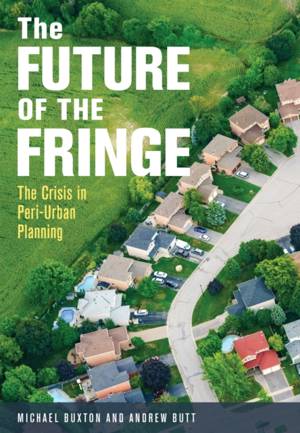
Bedankt voor het vertrouwen het afgelopen jaar! Om jou te bedanken bieden we GRATIS verzending (in België) aan op alles gedurende de hele maand januari.
- Afhalen na 1 uur in een winkel met voorraad
- Gratis thuislevering in België
- Ruim aanbod met 7 miljoen producten
Bedankt voor het vertrouwen het afgelopen jaar! Om jou te bedanken bieden we GRATIS verzending (in België) aan op alles gedurende de hele maand januari.
- Afhalen na 1 uur in een winkel met voorraad
- Gratis thuislevering in België
- Ruim aanbod met 7 miljoen producten
Zoeken
The Future of the Fringe
The Crisis in Peri-Urban Planning
Michael Buxton, Andrew Butt
Paperback | Engels
€ 70,45
+ 140 punten
Omschrijving
Peri-urban landscapes are some of the world's most vulnerable areas. Although they are often thought of simply as land awaiting development, these landscapes retain important natural resources and make valuable contributions to agriculture, water use, biodiversity conservation, landscape preservation and human well-being. Billions of people use them and enjoy their natural values. Their continuing loss threatens to alter our relationships with nature and have a negative impact on the environment. The Future of the Fringe first explores the history of peri-urban areas, international peri-urban policy and practice, and related concepts. It analyzes internationally relevant issues such as green belts and urban growth boundaries, regional policy, land supply and price, and the concepts of liveability, attractiveness, well-being and rural amenity. It then examines a range of Australian peri-urban issues, as an extended case study. The book argues for a precautionary approach so that we retain the greatest number of options to adapt during rapid and unprecedented change.
- The first Australian book to examine Australian peri-urban issues in detail.
- Comprehensively reviews the international literature on peripheral urban ('peri-urban') landscapes and related issues.
- Analyzes contemporary debates on contentious peri-urban issues, such as the future of green belts and peri-urban agriculture.
- Includes a section on international peri-urban policy and planning practice.
- Presents a strong argument for the preservation of the traditional rural landscapes of peri-urban areas.
Specificaties
Betrokkenen
- Auteur(s):
- Uitgeverij:
Inhoud
- Aantal bladzijden:
- 184
- Taal:
- Engels
Eigenschappen
- Productcode (EAN):
- 9781486308958
- Verschijningsdatum:
- 11/08/2020
- Uitvoering:
- Paperback
- Formaat:
- Trade paperback (VS)
- Afmetingen:
- 170 mm x 241 mm
- Gewicht:
- 498 g

Alleen bij Standaard Boekhandel
+ 140 punten op je klantenkaart van Standaard Boekhandel
Beoordelingen
We publiceren alleen reviews die voldoen aan de voorwaarden voor reviews. Bekijk onze voorwaarden voor reviews.












